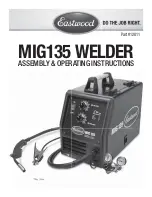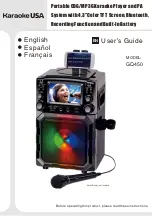
19
PLASMA CUTTER 85A / 125A
EN
Caution, welding in small work areas requires surveillance from a safe distance. In addition, the welding of certain materials containing lead, cadmium,
zinc, mercury or beryllium may be particularly noxious.
Do not weld in areas where grease or paint are stored.
FIRE AND EXPLOSIONS RISKS
Protect the entire welding area. Compressed gas containers and other inflammable material must be moved to a minimum safe
distance of 11 meters.
A fire extinguisher must be readily available.
Be careful of spatter and sparks, even through cracks.
It can be the source of a fire or an explosion.
Keep people, flammable objects and containers under pressure at a safe distance.
Welding of sealed containers or closed pipes should not be undertaken, and if opened, the operator must remove any inflammable or explosive
materials (oil, petrol, gas...).
Grinding operations should not be directed towards the device itself or any flammable materials.
GAS BOTTLE
Gas leaking from the cylinder can create a hazard if present in high concentrations around the work area.
Transport must be done safely: Cylinders closed and product off. Always keep cylinders in an upright position securely chained
to a fixed support or trolley.
Gas cylinders must be stored in an open or ventilated area. The cylinders must be in a vertical position secured to a support or trolley.
Close the bottle after any welding operation. Be careful with gas bottles placed in areas of high temperature, or in sunlight.
Cylinders should be located away from areas where they may be struck or subjected to physical damage.
Always keep gas bottles at a safe distance from arc welding or cutting operations, and any source of heat, sparks or flame.
Be careful when opening the valve on the gas bottle, it is necessary to remove the tip of the valve and make sure the gas meets your welding
requirements.
ELECTRIC SAFETY
The machine must be connected to an earthed electrical supply. Use the recommended fuse size.
An electrical discharge can directly or indirectly cause serious accidents, if not deadly.
Never touch live parts inside and outside of the device when it is powered on (Torches, clamps, cables, electrodes) as they are connected to the
welding circuit.
Before opening the device, it is imperative to disconnect it from the grid and wait 2 minutes. so that all the capacitors is discharged.
Do not touch the torch or electrode holder and earth clamp at the same time.
Be sure to change the cables and torches if they are damaged, to be performed by qualified and authorized personnel.
The dimensioning of these accessories should be sufficient.
Always wear dry clothes in good condition, in order to be insulated from the electrical circuit. Wear insulating shoes, regardless of the environment
in which you work in.
EMC CLASSIFICATION
These Class A devices are not intended to be used on a residential site where the electric current is supplied by the public
network, with a low voltage power supply. There may be potential difficulties in ensuring electromagnetic compatibility on these
sites, because of the interferences, as well as radio frequencies.
These devices are not compliant with the CEI 61000-3-12 standard. On a public low-voltage power grid, it is the responsibility
of the installer or user of the device to ensure, by checking with the operator of the distribution network, which device can be
connected.
ELECTROMAGNETIC INTERFERENCES
The electric currents flowing through a conductor cause electrical and magnetic fields (EMF).
All welders should use the following guidelines to minimize exposure to electromagnetic fields from the welding circuit
- Regroup the electrode cables and earth clamp. If possible, attach them with tape
- Do not roll the electrode cable, torch or the earth clamp around the body.
- Do not stand between the cables. If the electrode cable or torch is on the right, the work cable should also be on the right.
- Connect the earth cable to the workpiece, as close as possible to the welding area.
- Do not work next to the welding power source.
















































